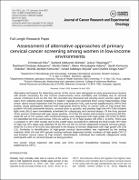| dc.contributor.author | Eilu, Emmanuel | |
| dc.contributor.author | Akinola, Saheed Adekunle | |
| dc.contributor.author | Tibyangye, Julius | |
| dc.contributor.author | Adeyemo, Rasheed Omotayo | |
| dc.contributor.author | Odoki, Martin | |
| dc.contributor.author | Adamu, Aliero Almustapha | |
| dc.contributor.author | Onkoba, Sarah Kemuma | |
| dc.contributor.author | Kemunto, Moindi Jeridah | |
| dc.contributor.author | Abyola, Ismail Adebayo | |
| dc.contributor.author | Kato, Charles Drago | |
| dc.date.accessioned | 2021-07-02T08:33:19Z | |
| dc.date.available | 2021-07-02T08:33:19Z | |
| dc.date.issued | 2021-01 | |
| dc.identifier.citation | Eilu, E., Akinola, S. A., Tibyangye, J., Adeyemo, R. O., Odoki, M., Adamu, A. A., Onkoba, S. K., Kemunto, M. J., Abyola, I. A., & Kato, C. D. (2021). Assessment of alternative approaches of primary cervical cancer screening among women in low-income environments. Journal of Cancer Research and Experimental Oncology, 13(1), 1-9. https://doi.org/10.5897/JCREO2020.0168 | en_US |
| dc.identifier.issn | 2141-2243 | |
| dc.identifier.uri | http://dir.muni.ac.ug/xmlui/handle/20.500.12260/406 | |
| dc.description.abstract | Alternative techniques for detecting cancer of the cervix uteri alongside its early precancerous lesions still remain necessary for low income environments since morbidity and mortality due to cervical cancer continues to be on the rise. We recruited one thousand and seventy-seven women aged 15-55 years from selected study hospitals in Eastern Uganda and examined them using Papanicolaou (Pap) smear, direct visual inspection with 5% acetic acid solution (VIA), and human papillomavirus (HPV) DNA testing. Study participants detected with high-grade lesions (HSIL) or cancer cells on Pap smear test, positive VIA test (acetowhite lesions, cervical ulcer or growth), and positive high-risk HPV DNA (relative light units (RLU) were immediately scheduled for colposcopy and cervical biopsy. Of the forty percent of the women confirmed with pap smear positive, 43 of the 63 women had invasive carcinoma (68.3%), while 89 out of 137 women with confirmed biopsy were diagnosed with high grade CIN (CIN2,3) (65%). DVI identified 46 of 63 carcinomas (73%) as well as 47 of 74 high grades CIN (CIN 2, 3) (64%). There was a variation in HPV DNA results due to the cutoff value considered in defining the final result. HPV DNA of high-risk HPV types was detected 39 (61.9%) out the 63 women diagnosed invasive cervical cancer, while 66 (73.3%) or 46 (51%) was detected in the biopsy of women diagnosed with high grade CIN (CIN 2,3). Similarity in identification of high-grade cervical abnormalities was registered by the testing methods. Both VIA and HPV genetic testing methods diagnosed similar numbers of high grade CIN 2,3 and invasive cancer cases as Pap smears. Nevertheless, individual test methods categorized study participants with no cervical disease as being positive. | en_US |
| dc.publisher | Journal of Cancer Research and Experimental Oncology | en_US |
| dc.subject | Visual inspection with acetic acid (VIA) | en_US |
| dc.subject | Cervical intraepithelial neoplasia (CIN) | en_US |
| dc.subject | Human papillomavirus (HPV) | en_US |
| dc.title | Assessment of alternative approaches of primary cervical cancer screening among women in low-income environments | en_US |
| dc.type | Article | en_US |

